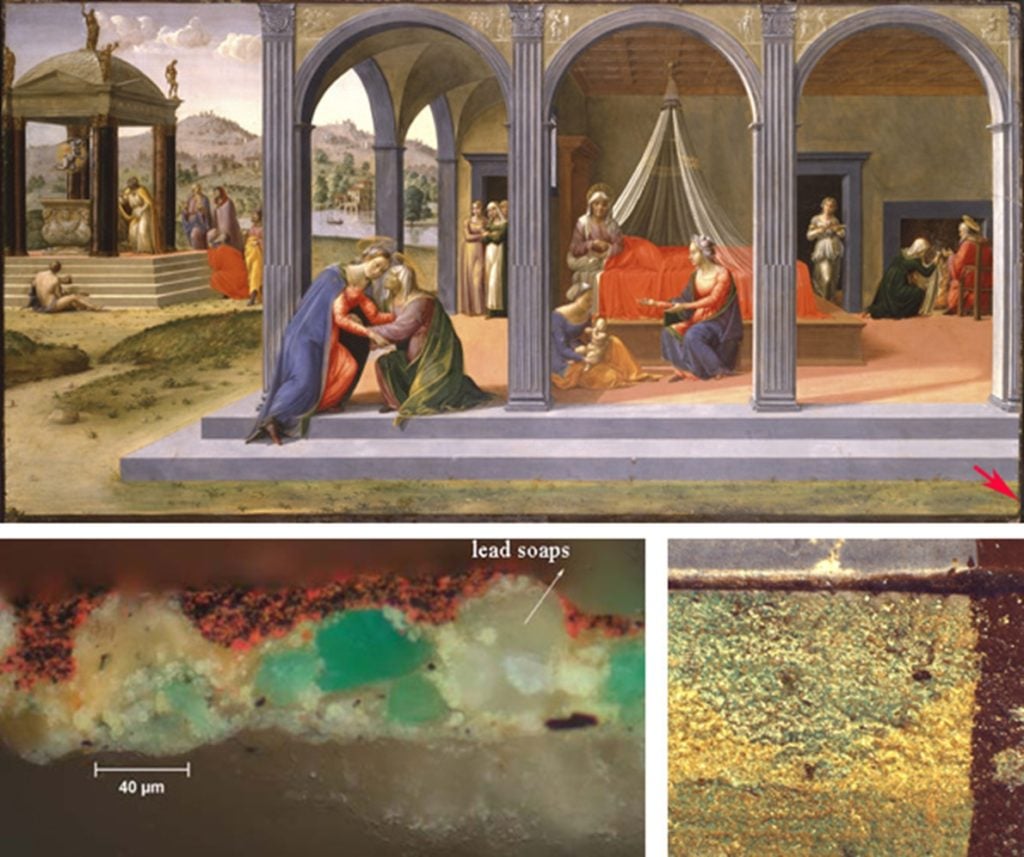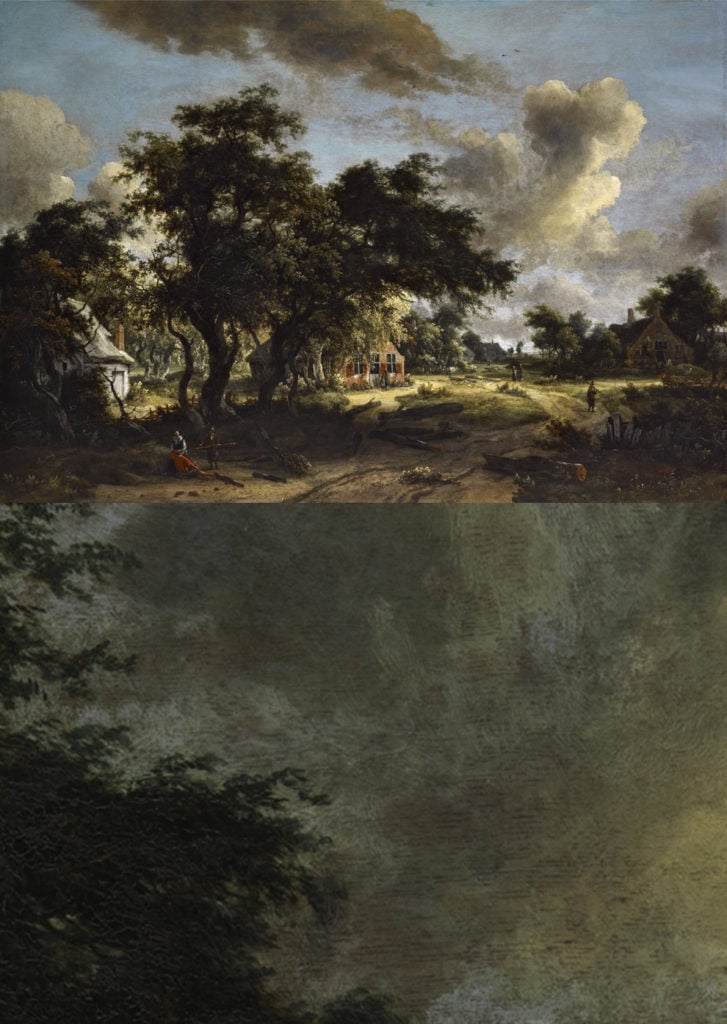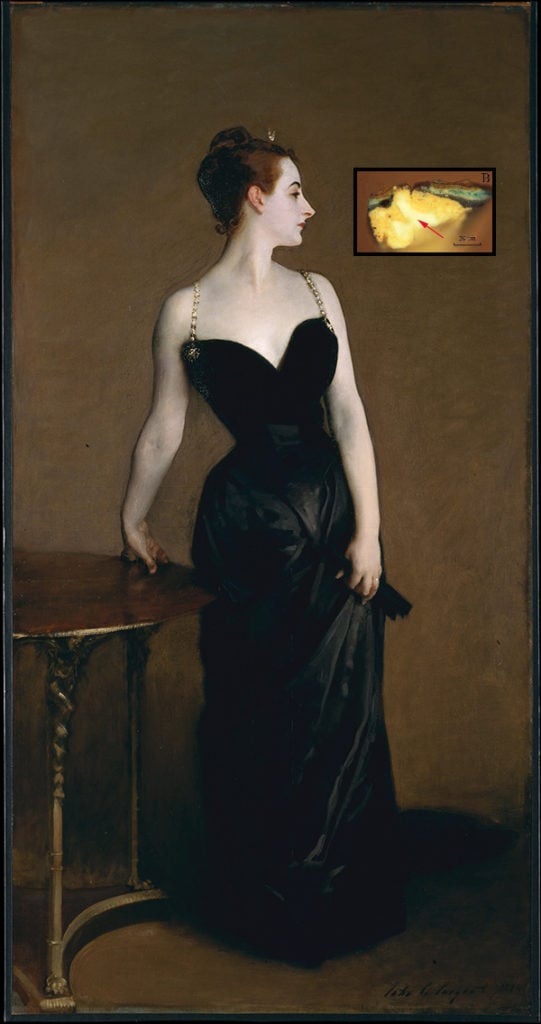Art World
There Is a Secret Villain Threatening the World’s Masterpieces. It’s Soap.
A mysterious chemical reaction is to blame.

A mysterious chemical reaction is to blame.

Sarah Cascone

A team of researchers are working to find a solution to an unlikely scourge that is marring the surfaces of canvases around the world: soap.
Conservation scientists say that tiny formations of lead-based soaps—each about a tenth of a millimeter in diameter—are threatening to mar paintings by artists ranging from Rembrandt van Rijn to Georgia O’Keeffe. A team of experts has spent years researching why these microscopic white pockmarks appear—but they can’t figure out how to stop them.
“We began to investigate the process and see if we could come up with some explanation so art conservators might have some idea how to correct the problem,” says University of Delaware professor Cecil Dybowski, who has been researching these pesky soaps over the last four years with Silvia A. Centeno, a research scientist at New York’s Metropolitan Museum of Art.
The long-term goal of the project, funded by a joint $590,000 grant from the National Science Foundation, “is to find out what factors affect the reaction itself and figure out procedures to ameliorate those problems,” Dybowski says. Through their work, Dybowski and his team have proven for the first time that water and humidity are major contributing factors in this soapy conservation nightmare.

Detail from Meyndert Hobbema, Village Among Trees (1655). This detail, before treatment, shows the transparency caused by soap formation that makes the dark pores of the wood grain visible. Courtesy of the Frick Collection, New York.
Potential for Destruction
The stakes are high enough to get any art lover in a lather. These small blemishes add up to give paintings a hazy appearance, and can also cause severe damage. If enough slippery metal soap forms on a painting’s surface, it can lead to delamination, and the paint can flake off the canvas in layers, destroying the artwork.
Soap also does not discriminate. Scientists have identified the presence of lead soap in all sorts of paintings, from works by Francisco Goya and Vincent van Gogh to Piet Mondrian, as well as works by contemporary artists. (The problem is so widespread that clever forgers even incorporate lead soaps to make a painting appear older.)
Ellen Baxter, the chief conservator of Pittsburgh’s Carnegie Museum of Art, recently encountered soap formations in Elizabeth Murray’s 1979 painting Try. To restore a pristine appearance, “you can try and burnish it, rub it with a q-tip, use a solvent on it, or you can try and pick them off manually,” Baxter tells artnet News. “I tried to take off some of the worst of them so it wasn’t quite so noticeable.” But this approach is tricky too. Because they are part of the paint film, removing the soaps is akin to moving a tiny part of the painting.

Paint cross-section MH146/B39 taken from The Anatomy Lesson of Dr. Nicolaes Tulp by Rembrandt van Rijn seen through various analytical imaging techniques. Courtesy of Katrien Keune and Jaap J. Boon.
What Do We Know?
Conservators have been working to solve this problem for almost 20 years. The initial discovery that soap was behind dusky surfaces came from Petria Noble, a conservator at the Rijksmuseum in Amsterdam, and Jaap Boon, a conservation scientist, in 1996.
The duo were getting ready to clean Rembrandt’s 1632 masterpiece The Anatomy of Dr. Nicolaes Tulp, and realized that the tiny white spots on the painting’s surface were actually lead soaps. (Previously, the prevailing theory was that tiny gas bubbles were forming and bursting through the paint, creating imperfections.)
Here’s how it works: over many years, as oil paint is exposed to heat and humidity, it becomes unstable and lead soap forms. Fatty oils naturally present in linseed oil—the most common oil in both historic and contemporary oil paint—combine with lead ions from the pigment. When the metal soaps form at or near the painting’s surface, they break through the paint, creating the tiny craters that populated the surface of the Rembrandt, and many other Old Masters.

Rembrandt van Rijn, The Anatomy Lesson of Dr. Nicolaes Tulp (1632). Courtesy of Wikimedia Commons.
And just because the lead soaps aren’t visible, doesn’t mean they aren’t there, lurking just under the surface, ready to erupt. Dybowski shared with us an image of a small cross-section of Madame X, the Met’s John Singer Sargent masterpiece (1883–84), which shows a soap inclusion growing just beneath the upper layer of paint.
“The oils consist of glycerol—which is like hand lotion—which have long chain fatty acids in them,” explains Dybowski. “They’re just molecules wandering around, but when they come in contact with the pigment, they form soap. Those aggregates eventually break through the layers of paint—if you allow this process to go on too long, it destroys the painting totally.”
One added challenge? Water is generally considered one of the safest cleaning products in the world of conservation—but that is not the case when it comes to lead soap. Instead, water may actually encourage the formation of the pesky substance and the unsightly imperfections it creates.

John Singer Sargent, Madame X (Madame Pierre Gautreau), 1883–84, and a cross-section of the work (inset) showing the presence of lead soap beneath the surface of the painting. Courtesy of the Metropolitan Museum of Art/Cecil Dybowski .
Unanswered Questions
Many unanswered questions remain. Because each artist’s materials are slightly different, and paintings are stored under different conditions, it is hard to know when free fatty acids will appear to trigger the problem. As Dybowski explains, the formation of the soaps “certainly has to do with the presence of the free fatty acids, but there are many processes that could lead to the presence of free fatty acids.”
In the meantime, conservators are doing their best to slow, stop, and prevent the soap formations. Dybowski’s team is generally unable to acquire large enough samples to test real Old Master paintings; instead, they create their own model paintings in the lab and do their best to replicate what is happening to works of art all over the world—despite the many variables involved.
Their research has consistently shown that exposure to water speeds up the formation of lead soaps. “On the other hand, if you dry these paintings out, there are other processes that can happen,” Dybowski warns. “There’s a trade-off.”
Baxter agrees: “Paintings absorb humidity and suddenly they’ve gotten mold, or they can swell and you have mechanical damage. Under low humidity they become really brittle and they go through chemical changes.”
In the wider realm of art conservation, lead soaps are just one relatively small problem among many. But researchers appear to be slowly getting closer to a solution. “It’s really bizarre,” Baxter says. “For things that are supposed to be so inanimate, paintings can be really animated… it’s always an adventure.”